December is the time when everywhere we go seems to smell of cookies and Mulled wine. And what do those have in common?! Well… probably cinnamon and cloves. And what do those two essential oils have in common? Eugenol, of course, we all know that right?!
I suppose many of you are reaching out for that Clove essential oil to spice up the holiday atmosphere at your home or workspace. Hence, Laura Činč Ćurić, M. Pharm. (the head of our research team) and I prepared a useful blog post for you covering some information about Clove essential oil.
Cloves are one of the world’s most important, popular, and useful plants. The essential oil is prized for its many valuable medicinal properties as well as its use in flavorings and perfumes. Cloves are used in Ayurveda, Chinese medicine as well as western herbalism, and dentistry, where the essential oil is sometimes used as an effective painkiller. It is no wonder that cloves were central to the early spice trade and their great value remains recognized today.
Cool fact:
Did you know that the Chinese emperors of the Han Dynasty, in the third century BC, required those who addressed them to chew cloves to freshen their breath?
The first thought most people have when thinking of Clove is that it is a spice, but did you know that Clove is actually a medium-sized tree? Here is one of my favorite photographs of the clove flower bud I took while traveling through India and studying local plants. Although native to native to the Maluku Islands (Moluccas) in east Indonesia, nowadays Clove is cultured in numerous countries in the world.
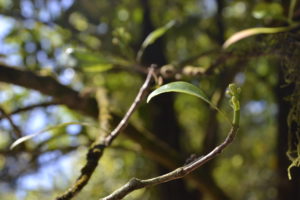
Melani’s picture of a clove tree
Clove is the common name for the abovementioned small, tropical evergreen tree. The accepted Latin name, according to The Plant List, is Syzygium aromaticum although when purchasing essential oils you will sometimes find it under several different synonyms such as Eugenia aromaticum or Eugenia caryophyllata.
(Note: We make sure that in Dropsmith you can search the oils with any of its known synonyms however only the most current one is displayed.)
Interesting fact:
The family Myrtaceae has at least 3000 species distributed in 130-150 genera. This includes some well-known representatives such as Eucalyptus, Myrtle, and Tea tree. Interestingly, all the abovementioned species are woody and have flower parts in multiples of four or five.
In the image below you can see the variety of essential oils you find on Dropsmith if filtering by the Botanical Family Myrtaceae.
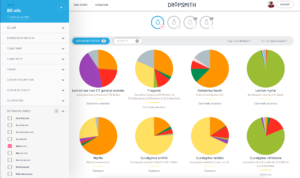
Clove is cultivated for the production of flower buds, which start to develop 4 years after the tree is planted. It is necessary to note that there are three types of clove essential oils:
- Clove bud oil, derived from the flower-buds of Syzygium aromaticum, consists of 60-90 % eugenol, including eugenyl acetate, caryophyllene, plus other minor constituents.
- Clove leaf oil, derived from the leaves of Syzygium aromaticum, made up of 82-88 % eugenol with little or no eugenyl acetate, and minor constituents.
- Clove stem oil, derived from the twigs of Syzygium aromaticum, with 90-95 % of eugenol content, amidst other minor constituents.
Fun fact:
Experts believe that the world’s oldest clove tree named Afo, is between 350 and 400 years old!
Chemical composition breakdown of Clove bud essential oil
Undergoing distillation, clove buds can yield up to 18 % of essential oil (dry weight). Which, in case you didn’t know, is quite rare and extraordinary.
Here is another useful reminder for all of you aromatherapy teachers out there who are into live distillation demonstration.
This is why we often use Clove buds in the laboratory when we demonstrate distillation.
It is simple to use.
- You can use dry material, so no need to search for a fresh material or the nearest tree to pick it off from 😉
- It is very accessible, you can buy it practically anywhere.
- And finally, it gives lots of essential oil for a small amount of material.
The main chemical component of the Clove bud essential oil is eugenol with a concentration range of 60-95 %. That is a significant percentage and it highly impacts the way you may safely use the essential oil. I will give you just one example out of several safety recommendations connected to eugenol content. In Tisserand and Young’s book, Essential Oil Safety, Second Edition, the recommended dermal maximum is 0.5% due to its high eugenol content. Therefore, a significant presence of eugenol will clearly influence the amount of Clove bud essential oils you will use in your final product. Do you know what other essential oils are rich in eugenol?
Other important compounds found in Clove essential oil are eugenyl acetate (2-15 %) and beta-caryophyllene (5-10 %). Eugenol is a well-studied component. In Dropsmith we have over 50 references just for eugenol alone! Some of the scientifically proven properties include antibacterial, muscle relaxant, anti-inflammatory, and many other useful properties.
The most widely known use of Clove bud is probably its analgesic properties commonly used for sooting toothache. However, the plant possesses highly potent antimicrobial and antibiofilm properties and can be used for the treatment of gingivitis and stomatitis. Before you reach out for the essential oil, please consider a much safer option and simply chew the Clove bud spice from your kitchen cabinet.
Essential oil extraction
I stomped upon an interesting article that tested if crushing the clove buds would make a difference in the final production of the essential oil. In the study, both batches were hydro-distilled (sample and water ratio was 1:5) for 24 hours. The oil yield of whole clove bud and crushed clove bud was 14.50% and 14.45% w/w, respectively.
It was the composition that changed! Isn’t that fascinating!?
That inspired me to conduct a little home distilling experiment myself and I will share this in one of my next blog posts – coming out soon
Sign up below to our mailing list and get informed when the blog post comes out as well as stay informed with Dropsmith news.

REFERENCES
- https://app.dropsmith.com/oils
- Andaya, Leonard Y. (1993). “1: Cultural State Formation in Eastern Indonesia”. In Reid, Anthony (ed.). Southeast Asia in the early modern era: trade, power, and belief. Cornell University Press.
- AT Mbaveng,V Kuete. (2017) Medicinal Spices and Vegetables from Africa, Chapter 29 – Syzygium aromaticum. Academic Press, Pages 611-625.
- Bensky, D., S. Clavey, and E. Stöger. 2004. Chinese Herbal Medicine: Materia Medica. Seattle, WA: Eastland Press.
- Diego Francisco Cortés-Rojas et al. (2014) Clove (Syzygium aromaticum): a precious spice. Asian Pac J Trop Biomed. 4(2): 90–96.
- Iwan Safrudin, Askal Maimulyanti, Anton Restu Prihadi. (2015) Effect of crushing of clove bud (Syzygium aromaticum) and distillation rate on main constituents of the essential oil. AJEONP; 2 (3): 12-15.
- Lawless, J. 1995. The Illustrated Encyclopedia of Essential Oils. Rockport, MA: Element.
- Lewis R. (2016) Clostridium diffcile infection in the clinical setting: challenges and potential aromatic solutions. International Journal of Clinical Aromatherapy, Volume 11 issue 2, 18-31.
- M. Hakkı Alma, Murat Ertaş, a Siegfrie Nitz, and Hubert Kollmannsbergerb. (2007) Chemical composition and content of essential oil from the bud of cultivated Turkish clove (Syzygium aromaticum L.) BioResources 2(2), 265-269.
- Madeira SV, Rabelo M, Soares PM, et al. (2005) Temporal variation of chemical composition and relaxant action of the essential oil of Ocimum gratissimum L. (Labiatae) on guinea-pig ileum. Phytomedicine. 12(6-7):506-9.
- Miladi H, Zmantar T, Kouidhi B, Chaabouni Y, Mahdouani K, Bakhrouf A, Chaieb K.(2017) Use of carvacrol, thymol, and eugenol for biofilm eradication and resistance modifying susceptibility of Salmonella enterica serovar Typhimurium strains to nalidixic acid. Microbial Pathogenesis, Volume 104, 56-63.
- Sophia Zougagh,correspondin, Ayoub Belghiti, Tarik Rochd, Ilham Zerdani, and Jamal Mouslim. (2019) Medicinal and Aromatic Plants Used in Traditional Treatment of the Oral Pathology: The Ethnobotanical Survey in the Economic Capital Casablanca, Morocco (North Africa). Nat Prod Bioprospect; 9(1): 35-48.
- Tisserand, R. and Young, R. (2014) Essential Oil Safety 2nd Edition. Edinburgh: Churchill Livingstone; 254-257.
- The world’s oldest clove tree, By Simon Worrall Ternate, Indonesia (https://www.bbc.com/news/magazine-18551857
- Tung YT, Chua MT, Wang SY, Chang ST. (2008) Anti-inflammation activities of essential oil and its constituents from indigenous cinnamon (Cinnamomum osmophloeum) twigs. Bioresource Technology, 99(9):3908-3913.
- http://www.theplantlist.com/ (December 2020)

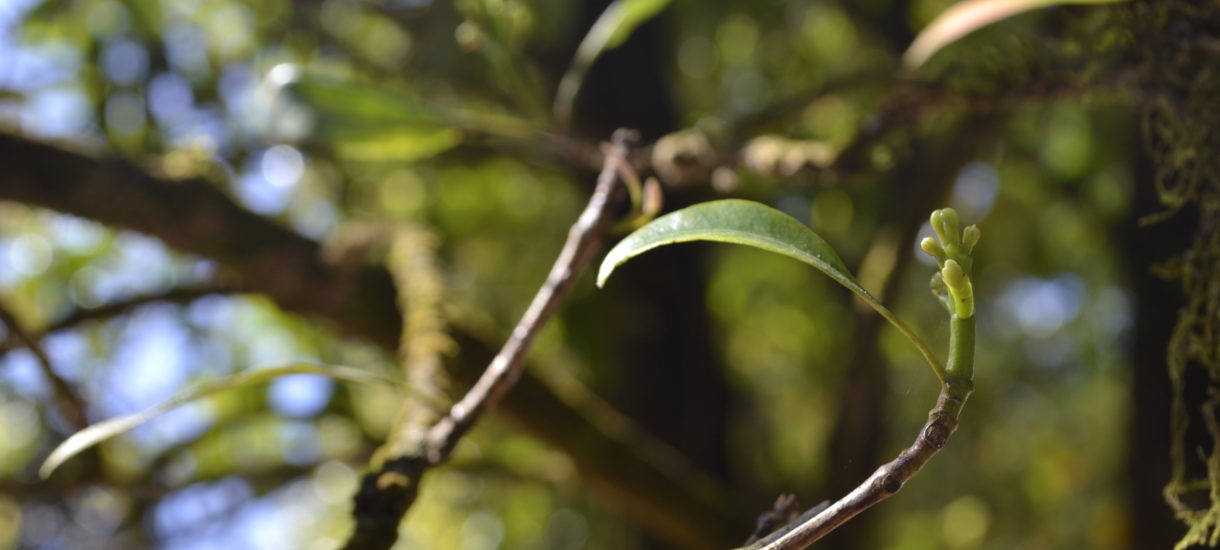

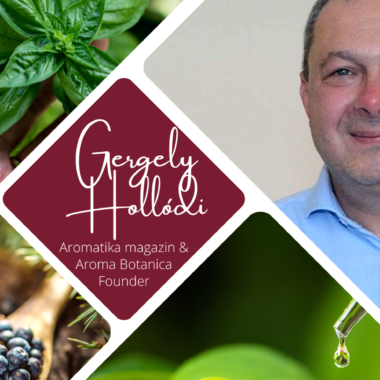

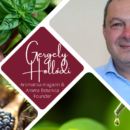

Is basil eo also rich in eugenol?
Great question Helena! Actually, it depends on which Basil essential oil we are talking about. Basil has various species as well as chemotypes. Holy basil also known as Tulsi (Ocimum sanctum) is the one with the highest eugenol component however, when we say ‘Basil essential oil’ we ‘assume’ it is Ocimum basilicum. This species of basil has several chemotypes and some of them do contain a smaller amount of eugenol. The chemotype you want to which out here, because of the safety precautions, is more Basil chemotype methyl chavicol. You can check out all of that and more in Dropsmith’s search 🙂 I think Basil essential oils could be a good topic for another blog post. What do you think?